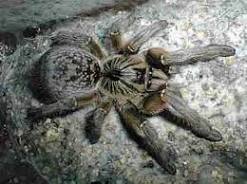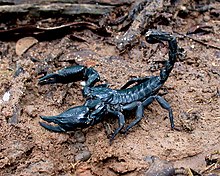Rear Horned Baboon Tarantula (Ceratogyrus darlingi)
| Scientific classification |
|
|---|---|
| Domain: | Eukaryota |
| Kingdom: | Animalia |
| Phylum: | Arthropoda |
| Subphylum: | Chelicerata |
| Class: | Arachnida |
| Order: | Araneae |
| Infraorder: | Mygalomorphae |
| Family: | Theraphosidae |
| Genus: | Ceratogyrus |
| Species: |
C. marshalli
|
Ceratogyrus marshalli, also known as Straight Horned Baboon or Great Horned Baboon Tarantula, is a species of tarantula from the genus Ceratogyrus. It is found in Zimbabwe and Mozambique.[1] It was first described by Reginald Innes Pocock in 1897, as half of the Ceratogyrus genus, they own a impressive horn in the carapace.
Description
Females live from 8 to 10 years, while males only live 3 to 4.[2] With a body length of 6 cm and a 15 cm legspan it is a fairly large species of Ceratogyrus.[3] Their carapace is black with some light brown striping, of course their being their namesake straight black horn. Their opisthosoma is light brown, covered in black spotting, although sometimes a fishbone pattern is apparent. Their legs are a light brown, or grey depending on visible conditions.
Ceratogyrus darlingi know also by the common name Rear Horned Baboon is an Old World, fossorial species known for its unique curved foveal horn. This species is endemic to the African countries of Botswana, Zimbabwe, Mozambique,and South Africa. A fossorial species means that the spider is an obligate burrower and makes its home in deep burrow it digs and spends a lot of its time hidden in its extensive underground tunnels. This is commonly refereed to as a pet hole. C. darlingi is also known as being a prolific webber, especially if you don’t provide deep enough substrate for it to burrow in, and will very quickly web up the area all around its burrow in the most beautiful manner. This is a fast growing species that grows from around ½” to nearly 4” within 2 years with most of that growth taking place within the 1st year. Females of this species can grow up to 5” and live about 10-12 years with some claiming as long as 15 years. Males, of course, don’t grow nearly as large as the females, mature around 2 years, and usually don’t live longer than 3 or 4 years. Being an Old World tarantula from the Eastern Hemisphere, this species does not have urticating hairs, and relies mainly on its fangs and powerful venom for defense. No reliable and in depth scientific studies have been done on the effects of their venom on humans, but symptoms have included muscle pain, headaches, and nausea. It is not something I would recommend going through so avoid handling this tarantula and be mindful when interacting with it.
Husbandry for this species is pretty straight forward. Because they are fossorial, they require more depth in their enclosure than your basic terrestrial set up. As slings i use a large dram vial or tall acrylic enclosure and fill it at least ⅔ up with substrate...and I keep the substrate slightly moist as slings so they don’t dry out (also known as desiccation). I will drop water on its webbing every few days to ensure it has access to water if it needs a drink, but I don’t mist their enclosure. I use the same set up for juveniles just with a larger acrylic enclosure and provide them wit a small water dish I keep full with clean water. and as adults, I provide them with a 5 gallon enclosure and fill it over halfway...if not ⅔ up with substrate. You want to provide them with plenty of room to burrow. If you do not give them enough substrate to make their burrow, they will web up the entrance of their burrow even more excessively than usual..which may look cool, but needlessly stresses out your T, so be a cool kid and let that spider dig. I provide a water dish and a few plants or objects near its burrow for it to use as anchor points for its webbing but there is really no need to provide a hide for this species. I keep their substrate dry and occasionally overflow their water dish to dampen the substrate on one side of the enclosure. I keep my Rear horned baboons at the same room temperature I keep most all my spiders, if you're comfortable, they are comfortable.
This T is a powerhouse when it comes to eating. Even as slings they quickly pounce on their prey and have an amazing feeding response, only refusing food while in pre molt. As slings I feed my C. darlingi prekilled small crickets or roaches twice a week until they refuse food and am sure to remove any uneaten prey with 24 hours. As juveniles I feed them 2 or 3 medium crickets one a week (sometimes twice a week depending on the size of the abdomen)/ And as adults I will feed them 3 or 4 large crickets a week...more or less depending again on the size of their abdomen, and I always make sure to remove any uneaten prey or leftover pieces of prey within 24 hours and I wait about 10 days after a molt before attempting to feed them again.
This isn't the most colorful species of tarantula out there, but what it lacks in bright color, it makes up for with its truly unique appearance. This T is usually considered a pet hole, especially when younger, but my adult female spends a fair amount of time just outside her burrow when she begins looking for a meal, though I have never seen her venture very far. I am luckily that mine will usually come out of hiding to eat but once she has had her fill, she will quickly retreat to the safety of her hole. Overall this is an easy species to care for, but they can be very defensive and quick and being an OW baboon species, this may not be an ideal first tarantula. But once you have some experience and confidence under your belt, this will make an awesome addition to your collection.
Habitat
They can be found in Harare, Zimbabwe, where this section will be referring to. This area is considered to have a subtropical highland climate. The average temperature here is 19°C, with average yearly rainf
Ceratogyrus marshalli, also known as Straight Horned Baboon or Great Horned Baboon Tarantula, is a species of tarantula from the genus Ceratogyrus. It is found in Zimbabwe and Mozambique.[1] It was first described by Reginald Innes Pocock in 1897, as half of the Ceratogyrus genus, they own a impressive horn in the carapace.
Description
Females live from 8 to 10 years, while males only live 3 to 4.[2] With a body length of 6 cm and a 15 cm legspan it is a fairly large species of Ceratogyrus.[3] Their carapace is black with some light brown striping, of course their being their namesake straight black horn. Their opisthosoma is light brown, covered in black spotting, although sometimes a fishbone pattern is apparent. Their legs are a light brown, or grey depending on visible conditions.
Habitat
They can be found in Harare, Zimbabwe, where this section will be referring to. This area is considered to have a subtropical highland climate. The average temperature here is 19°C, with average yearly rainfall of 805mm, since it is found 1500m above sea level, it has a surprisingly stable temperatures.[4][5][2]
Behavior
They are a very defensive spider, as most tarantulas it will first try to flee, if unable it will result in stridulation or a bite. They are burrowing and will make a vertical tunnel leading to a burrow in the end. At daytime they will most likely be in said burrow, and at night she will stay vigilant at the edge of her tunnel.[2]
all of 805mm, since it is found 1500m above sea level, it has a surprisingly stable temperatures.[4][5][2]
Behavior
They are a very defensive spider, as most tarantulas it will first try to flee, if unable it will result in stridulation or a bite. They are burrowing and will make a vertical tunnel leading to a burrow in the end. At daytime they will most likely be in said burrow, and at night she will stay vigilant at the edge of her tunnel.[2]


